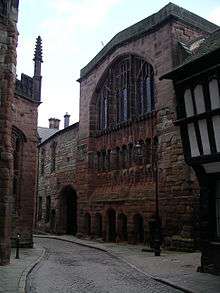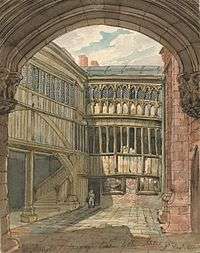St Mary's Guildhall
| St Mary's Guildhall | |
|---|---|
 The entrance to St Mary's Hall on Bailey Lane | |
| Alternative names | St Mary's Hall |
| General information | |
| Architectural style | Medieval |
| Address | Bayley Lane |
| Town or city | Coventry |
| Country | United Kingdom |
| Coordinates | 52°24′28″N 1°30′28″W / 52.4077°N 1.5078°WCoordinates: 52°24′28″N 1°30′28″W / 52.4077°N 1.5078°W |
| Owner | Coventry City Council |
| Website | |
|
www | |
St. Mary's Hall is a guildhall built in Coventry, Warwickshire, England, first built 1340–42 and much altered and extended c. 1392–1430, The building has a vaulted undercroft which is currently a restaurant.[1]
History

The guildhall originally served as the headquarters of the merchant guild of St. Mary, and subsequently of the united guilds of the Holy Trinity, St. Mary, St. John the Baptist and St. Katherine. Following the suppression of guilds in 1547, for a time it served as the city's armoury and (until 1822) its treasury,[2] as well as the headquarters for administration for the city council until the Council House was opened in 1920.
In November 1569, following the Catholic Rising of the North, Mary Queen of Scots was rushed south from Tutbury Castle to Coventry.[3][4] Elizabeth I sent a letter, instructing the people of Coventry to look after Mary.[5] She suggested that Mary be held somewhere secure such as Coventry Castle. However, by that time it was too decayed and Mary was instead first held at the Bull Inn, Smithford Street before being moved to the Mayoress's Parlour in St. Mary's. Following the defeat of the rebels, Mary was once more sent north to Chatsworth in May 1570.
George Eld, mayor of Coventry (1834–5) was an antiquarian who encouraged appreciation of Coventry's ancient buildings. He initiated the restoration of the fourteenth-century interior of the mayoress's parlour.[6]
In 1861, the artist David Gee painted The Godiva Procession Leaving St. Mary's Hall, which is now on display in the Herbert Art Gallery and Museum, Coventry.[7]
Restoration work by the council received the approval of the committee of the Coventry City Guild in 1930. Improvements had included the repair of the door at the north entrance to the crypt and providing glass and grilles in the windows of the fore crypt. Outside the crumbling exterior stonework was stabilized.[8]
The building retains a collection of royal portraits from the seventeenth to nineteenth centuries, arms and armour, fine stained glass and one of the country's most important tapestries dating from circa 1500.[9]
See also
| Wikimedia Commons has media related to St. Mary's Guildhall. |
References
- ↑ http://www.stmarysguildhall.co.uk
- ↑ Fox (1957), pp. 96, 101, 175.
- ↑ Marie Stuart Society Mary, Queen of Scots: England
- ↑ "Step inside Coventry's Guildhall". BBC Coventry and Warwickshire. BBC. 19 October 2009. Retrieved 16 October 2012.
- ↑ http://www.stmarysguildhall.co.uk: St. Mary's Guildhall
- ↑ Joanne Potier, ‘Eld, George (1791–1862)’, Oxford Dictionary of National Biography, Oxford University Press, 2004
- ↑ Reader offers: Coventry Telegraph 26 November 2001
- ↑ The Times, News in Brief, 16 April 1930
- ↑ http://www.stmarysguildhall.co.uk/info/5/history/9/the_coventry_tapestry